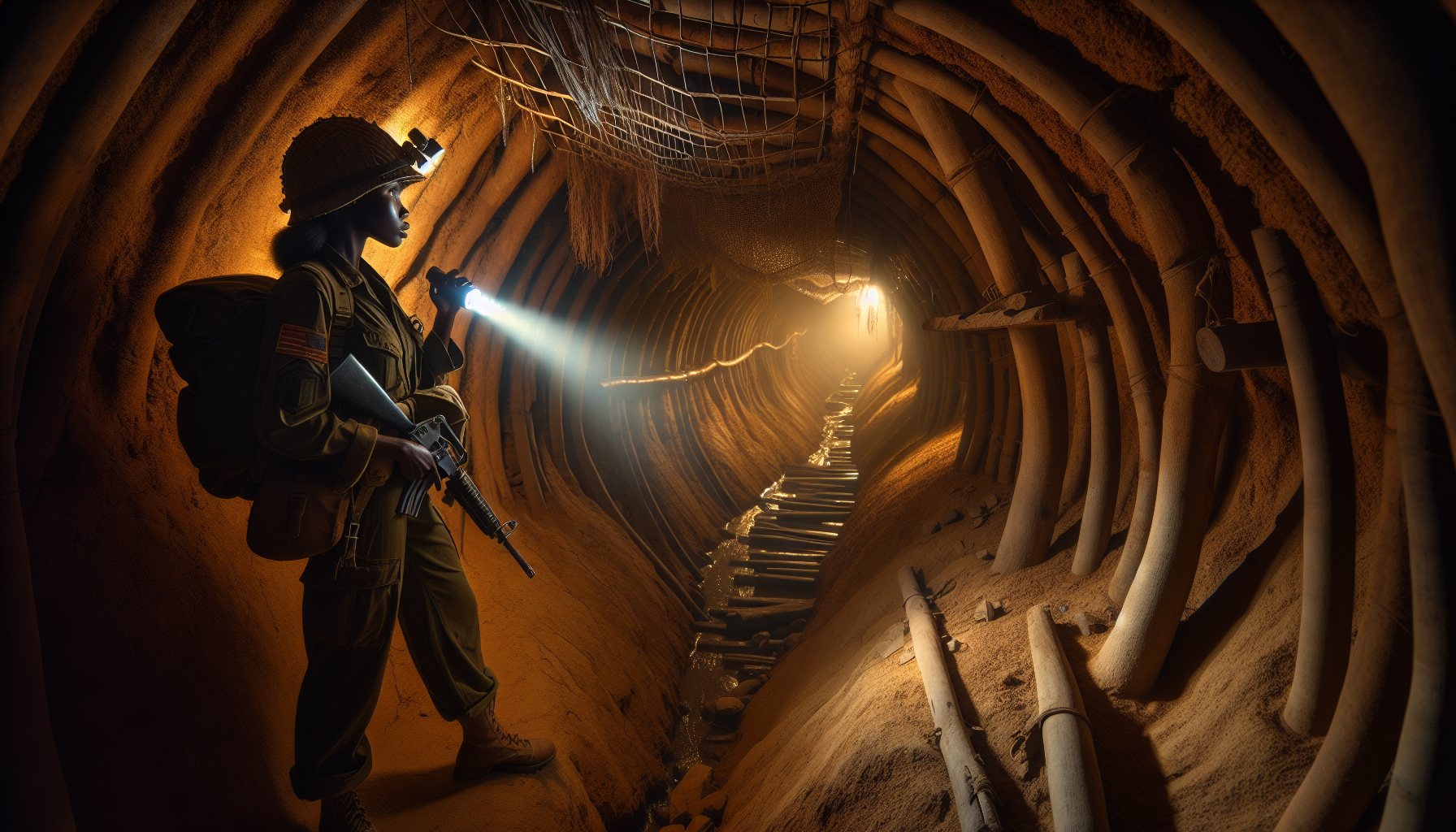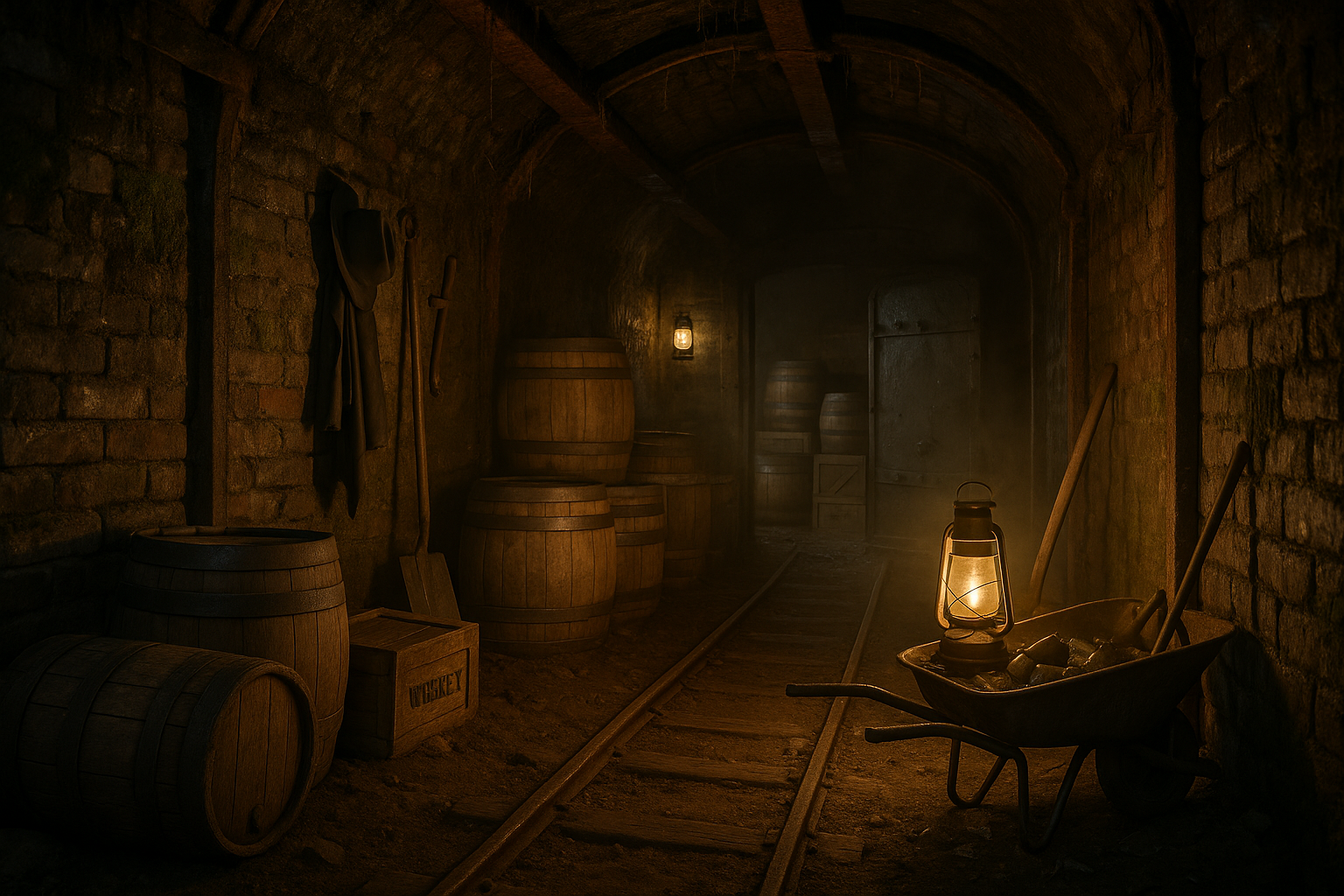In the dense, humid jungles of Southeast Asia, beneath the vibrant canopy of Vietnam’s sprawling landscapes, lies a silent testament to human ingenuity and resilience: the intricate tunnel networks used during the Vietnam War. 🌿 These subterranean passageways, shrouded in mystery and shadow, weave a complex narrative of survival, strategy, and sacrifice. As we embark on a journey to uncover these hidden secrets, we delve into a world where light barely reaches, but where history echoes powerfully through the darkness.
During the Vietnam War, the Cu Chi tunnels and other networks became an essential component of the Viet Cong’s strategy, offering refuge, supply routes, and a means to launch surprise attacks. But these tunnels are more than just historical relics; they are profound symbols of the human spirit’s capacity to adapt and endure under the most extreme conditions. In this article, we will explore the construction and functionality of these networks, the lives of those who inhabited them, and their enduring legacy in both historical and cultural contexts. Through this exploration, we hope to shed light on a remarkable chapter of history that remains relevant to this day.
As we dig deeper into the earth, we uncover how these tunnels were not merely pragmatic solutions to warfare but were also a testament to the creativity and tenacity of their creators. We will examine the ingenious methods employed in their construction, the complex systems that allowed them to operate effectively, and the strategic advantages they provided. From the simple, narrow passages to the more elaborate and fortified rooms, each segment of the tunnel system reveals a story of innovation born out of necessity. 🛠️
The human aspect of the tunnel networks is equally compelling. Life within these confines was challenging, with limited resources, constant threats, and the ever-present psychological toll of living underground. Yet, these tunnels were home to many, serving as living quarters, hospitals, and command centers. We’ll delve into personal accounts and historical records that illuminate the day-to-day realities faced by the soldiers and civilians who sought shelter and solace within these walls. Their stories paint a vivid picture of courage and endurance in the face of adversity.
Finally, we will reflect on the legacy of the Vietnam War’s tunnels in today’s world. How do these underground networks continue to influence modern military tactics? What lessons can we learn from their existence about conflict, resourcefulness, and the human condition? As we navigate the past, we invite you to consider the ways in which history informs our present and future. Join us as we uncover the hidden secrets of the Vietnam War’s tunnel networks and explore the indomitable spirit that built them.
The Genesis of the Vietnam War Tunnels
The tunnel systems of the Vietnam War are one of the most intricate and fascinating aspects of the conflict, revealing the resilience and ingenuity of the Vietnamese people. These tunnels, primarily located in the Cu Chi and Vinh Moc areas, were part of a vast underground network that extended throughout Vietnam. Originally constructed to combat French colonial forces, these tunnels were expanded and perfected during the Vietnam War as a strategic advantage against American forces.
The origin of these tunnels dates back to the late 1940s, when the Viet Minh, fighting against French occupation, began creating underground systems for shelter and supply routes. By the time of the American involvement in the 1960s, the tunnels had become a complex network that included living quarters, kitchens, weapon factories, and even hospitals. The tunnels were not just physical constructs; they represented the tenacity and strategic thinking of the Vietnamese, allowing them to conduct guerrilla warfare effectively.
Understanding the Structure and Functionality
The Cu Chi tunnels, in particular, are legendary for their complexity and functionality. Stretching over 250 kilometers, these tunnels played a crucial role in the Vietnamese strategy. As you explore the intricacies of these tunnels, it’s important to understand their multifaceted use in the war effort. Each section of the tunnel had a specific function, ensuring the survival and effectiveness of those who utilized them.
For a better understanding, let’s break down the main components and uses of these tunnels:
- Living Quarters: These areas were equipped with basic necessities, allowing Vietnamese fighters to live underground for extended periods.
- Command Centers: Strategically placed within the tunnel network, these centers facilitated communication and planning of attacks.
- Supply and Storage Areas: Essential for storing food, weapons, and ammunition, keeping them safe from enemy discovery.
- Medical Facilities: These included makeshift hospitals where wounded soldiers could be treated away from the battlefield.
- Booby Traps: The tunnels were rigged with traps to deter and harm enemy soldiers who dared to enter.
The table below provides a comparative overview of the Cu Chi and Vinh Moc tunnels, highlighting their unique features and historical significance:
| Feature | Cu Chi Tunnels | Vinh Moc Tunnels |
|---|---|---|
| Location | Cu Chi District, near Ho Chi Minh City | Quang Tri Province, North Vietnam |
| Length | Over 250 km | About 2.8 km |
| Main Use | Military operations and shelter | Civilian protection and logistics |
| Notable Features | Complex multi-level networks, booby traps | Deep tunnels, living quarters for entire villages |
The Impact on the Vietnam War
The tunnels had a profound impact on the course of the Vietnam War, often turning the tide of battle in favor of the Vietnamese. The strategic use of these tunnels allowed Vietnamese forces to conduct guerrilla warfare, striking swiftly and retreating back into the safety of the underground network. This approach frustrated and confused American forces, who were often unable to adapt to this unconventional warfare.
American soldiers found themselves at a significant disadvantage, as the tunnels allowed Vietnamese forces to disappear and reappear at will. The psychological impact on American troops was immense, as they faced an invisible enemy who could strike from anywhere. Attempts to destroy these tunnels through bombing and chemical warfare proved largely ineffective, as the tunnels were designed to withstand such assaults.
Moreover, the tunnels provided a logistical advantage, enabling the transport of supplies and reinforcements without detection. This ability to move undetected and maintain a steady supply line was crucial for the Vietnamese, especially during prolonged sieges and battles. The tunnels also served as a means of escape and refuge, preserving the fighting capability of Vietnamese forces even in dire situations.
Personal Accounts and Stories
The stories of those who lived and fought in the tunnels offer a poignant glimpse into the realities of war. The resilience and resourcefulness required to survive in such harsh conditions are a testament to the human spirit. For example, Vietnamese soldiers and civilians often spent days or weeks underground, enduring cramped and unsanitary conditions.
There are numerous accounts of incredible bravery and ingenuity. One notable story involves a young Vietnamese soldier who, despite being severely wounded, managed to guide his comrades through the tunnels to safety. Such stories highlight the personal sacrifices and determination that characterized the Vietnamese war effort.
For a visual exploration of these experiences, watch the video titled “Inside the Cu Chi Tunnels – Vietnam War Experience” on the channel Vietnam Military History. This video provides an immersive look into the tunnel systems and the lives of those who used them. Watch the video.
The Modern Legacy of the Tunnel Networks
Today, the tunnels stand as a symbol of resilience and ingenuity. They have become a major tourist attraction, drawing visitors from around the world who wish to explore this unique aspect of military history. Guided tours offer a firsthand experience of the tunnels, allowing visitors to crawl through sections and witness the various features that made them so effective.
In addition to tourism, the tunnels serve as a powerful reminder of the complexities of war and the lengths to which people will go to defend their land and way of life. They offer lessons in strategy and survival, as well as a deeper understanding of the Vietnam War’s impact on both the Vietnamese people and the world.
The preservation and education efforts surrounding the tunnels ensure that future generations can learn from this pivotal chapter in history. Museums and educational programs provide context and background, enhancing the visitor experience and promoting a deeper appreciation of the challenges faced by those who lived through the war.
Visiting the Tunnels
For those interested in visiting, the Cu Chi and Vinh Moc tunnels offer unique insights into the Vietnam War. Tours are available that take visitors through parts of the tunnels, complete with informative guides who provide historical context and share stories of those who lived and fought there. The experience is both humbling and enlightening, offering a tangible connection to the past.
When planning a visit, consider the following tips:
- Research Before You Go: Understanding the historical significance of the tunnels will enhance your visit.
- Wear Comfortable Clothing: The tunnels can be cramped and require some physical maneuvering.
- Respect the Site: Remember that these tunnels are a solemn reminder of a tumultuous period in history.
The Vietnam War tunnels are a testament to human resilience and the complexities of conflict. They continue to captivate and educate, offering valuable lessons and insights into the nature of warfare and the spirit of those who endured it. For a deeper exploration, consider visiting the tunnels or watching documentaries and interviews that bring their stories to life.

Conclusion
In conclusion, exploring the intricate tunnel network of the Vietnam War reveals a compelling narrative of resilience, ingenuity, and the complexities of warfare. The Cu Chi Tunnels, as a microcosm of the larger network, symbolize the strategic acumen of the Viet Cong and their unwavering determination in the face of overwhelming odds. These tunnels were not mere underground pathways; they were a lifeline, a place of refuge, and a strategic advantage that significantly influenced the course of the war.
Throughout our exploration of this topic, we’ve uncovered several pivotal points that underscore the significance of these tunnels. First, the sheer complexity and extensiveness of the tunnel network are a testament to the resourcefulness of the Viet Cong. Spanning hundreds of kilometers, these tunnels were equipped with living quarters, hospitals, storage facilities, and even weapons factories, all concealed beneath the ground. This subterranean world was ingeniously designed to withstand aerial bombardments and ground assaults, enabling the Viet Cong to launch surprise attacks and disappear into the earth like ghosts.
Second, the psychological impact of the tunnels on both the Viet Cong and the American soldiers cannot be overstated. For the Viet Cong, the tunnels offered a sense of security and empowerment, allowing them to strike unpredictably. For the American forces, the tunnels were a source of constant anxiety and fear, often leading to claustrophobic confrontations with an invisible enemy. The presence of the “tunnel rats,” brave soldiers tasked with entering and clearing these confined spaces, further illustrates the daunting challenges posed by this underground warfare.
Moreover, the tunnels highlight the broader themes of adaptability and resilience in the context of asymmetric warfare. The Vietnam War was characterized by the clash of a technologically superior force against a highly motivated and resourceful adversary. The tunnels exemplify how determination and innovative tactics can level the playing field, challenging conventional military paradigms.
As we reflect on these insights, it’s crucial to acknowledge the lasting impact of the Vietnam War and its lessons on contemporary military strategies. The tunnels serve as a reminder of the human capacity for creativity in times of adversity and the importance of understanding the cultural and geographical context in warfare. They also prompt us to consider the ethical dimensions of war, particularly the human cost and the long-lasting scars left on both combatants and civilians.
In the spirit of fostering a deeper understanding and appreciation of history, I encourage you to further explore the Vietnam War’s tunnel networks and their historical significance. There are numerous resources available online that provide detailed accounts and analyses, such as Smithsonian Magazine and National Geographic, which offer fascinating insights into this hidden world beneath the surface.
Finally, I invite you to engage with this topic actively. Share this article with friends, family, or colleagues who might find the story of the tunnels as intriguing as you did. Discuss the implications of the Vietnam War’s tactics in today’s world and how they can inform current military and geopolitical strategies. Your comments and insights are valuable, and by sharing your thoughts, you contribute to a richer, more nuanced dialogue.
In closing, may this exploration of the Vietnam War’s tunnel network inspire you to uncover hidden stories, question established narratives, and appreciate the complexity of history. Let it remind us all of the power of resilience and ingenuity in overcoming challenges, no matter how insurmountable they may seem. Together, let’s continue to learn from the past to build a more informed and empathetic future. 🌍
Toni Santos is a visual storyteller and artisan whose work explores the quiet power of what lies beneath. With a deep fascination for subterranean and hidden architecture, Toni uncovers the layers, voids, and forgotten spaces that shape our built environment from the shadows.
His art is a journey through the unseen — from ancient underground chambers to sealed passageways, service tunnels, and foundations buried in time. Each creation tells a story of silence, secrecy, and structure — revealing how absence and concealment can be just as meaningful as what’s visible above ground.
Whether working through visual compositions, architectural studies, or symbolic handcrafted pieces, Toni captures the soul of hidden spaces. His work bridges art and archaeology, blending design with discovery. Trained in visual design and traditional techniques, Toni creates with intention. His pieces don’t just depict — they interpret, inviting viewers to rethink what space, memory, and architecture mean when they’re hidden from view.
As the creative force behind Vizevex, Toni shares this perspective through curated visual narratives, symbolic collections, and interpretive essays that give voice to the quiet geometries beneath our feet.
His work is a tribute to:
The mystery of spaces built to be forgotten
The symbolism embedded in foundations, voids, and passageways
The timeless connection between human intention and hidden structure
Whether you’re an artist, an urban explorer, or someone fascinated by the unseen frameworks that support our world, Toni invites you into a realm where architecture becomes myth — one corridor, one layer, one buried story at a time.





